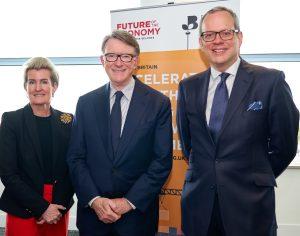The way organisations have begun to see their relationships with each other has shifted radically in recent years. Sectors that were once poles apart like business and charity now feel a great deal of attraction, realising that when they come together their power will be stronger. It’s a stark contrast to the darker days of hostility between organisations.
“When I started out, in the 1970s, charity never talked to business,” says Jonathon Porritt, founder and director of Forum for the Future – a non-profit organisation working globally with business and government to create a sustainable future – as well as former chair of the Green Party and director of Friends of the Earth. “Most of the time environmental organisations were pointing the finger of blame at businesses for being the wicked despoilers of the environment.”
It’s hard to pinpoint an exact time when thoughts toward competition as the ideal state for business changed. Porritt feels the United Nations Conference on Environment and Development in Rio de Janeiro began, way back in 1992, to highlight the fact that working together could prove more effective than arguing amongst themselves. “There was no point in having this endless war of attrition,” Porritt says. “Business has incredible insight, resources, leadership capabilities and we need all of that deployed to help create this more sustainable world.”
A change in attitude this significant doesn’t just come from one single cause, though. First of all, the way the public have taken to technological advances has forced everyday organisations – not just tech giants like Facebook or Google – to shift their approach to keep up. Whether we’re looking at social media, viral content or the way they consume media, for the first time, individuals have a say in setting the agenda. Anne-Marie Huby, co-founder of fundraising platform JustGiving, says: “These things together are creating a different landscape to which charities, businesses and even governments have to adapt.”
But it’s not just the positive effects that are driving a new collaborative agenda. Despite purported recovery, you don’t have to look far to identify the lingering effects of recession and austerity with many an organisation still feeling the pinch. These institutions must adopt a degree of radicalism if they want to survive. “Shrinking resources mean that collaboration is absolutely essential to find solutions to problems,” says Michelle Wright, chief executive of social strategy agency Cause4.
General belt-tightening hasn’t been the only hough: it has also drawn people to enquire how fit for purpose these competitive mechanisms really are. “What’s happened with the crisis in the financial sector has shed a light on how business is conducted in the mainstream,” says Huby. “It’s created an appetite for more meaningful businesses.”
More simply though, there has been something of a general mood change over the last few decades; Paul Skinner, co-founder of collaborative and social marketing agency Agency of the Future, feels this can even be detected in the change of cultural touch-points. “Contrast Michael Jackson’s ‘I’m bad’ slogan with Barack Obama’s first election under the slogan: ‘yes, we can’,” he says. Comparing other 20th century mainstays with their modern equivalents – Encyclopaedia Britannica with Wikipedia, Disney with YouTube – show the extent to which organisations have come to rely on a collaborative mindset. This lends a fair amount of weight to Skinner’s statement: “We live in a time of reinvention.”
Evidently then, there are plenty of organisations and individuals seeking new ways of approaching the issues they’re facing. And there’s evidence that collaboration between relevant parties can help them deal with a volatility that would otherwise be hard to deal with.
“Whole markets can go down suddenly, with huge discontinuities for the business, and they’re also on the receiving end of rising expectations from consumers,” says Porritt. Fortunately, with an openness of conversation, organisations and enterprises can widen their oversight and are able to make smarter overall decisions. “They know what their suppliers are saying and what their business partners are thinking,” Porritt explains. “So what they’re able to do then is to marshal those insights collectively.”
But the beauty of this approach is more about how it can facilitate greater efficiencies. “There is a lot of really smart innovation going on,” comments Patrick Nash, chief executive of the digital service provider for charities and social enterprises, Connect Assist. His firm is currently engaged in some open conversations with parties across a range of sectors. “We’ve got a large corporate, a large government department and us – a medium-sized social enterprise – meeting together and talking about how, in collaboration, we’re able to do the job better.”
And this manner of thinking is becoming more deeply embedded in the fundamental ways start-ups behave in the wider market. “Technology enables us to open up for external consumption assets that we’ve built ourselves,” says Huby. Using application programmer interfaces (APIs) – that allow programmers access to basic code of solutions like JustGiving and to build integrated apps and services – has opened up relationships between the
enterprise and around 1,000 developers, generating mutual value for both parties. She comments, “it’s a cultural shift: the desire to join forces as opposed to competing.”
This touches on something fundamental. Whether using APIs, creating joint ventures or curating discussions, the real importance of collaboration is how it transforms the pool of resources an organisation has at its disposal and, regardless of whether its goals are financial or social in nature, this can only be considered a positive thing.
“The traditional competitive model behind organisations depended upon enclosed resources,” says Skinner. Essentially, a company would amass resources like intellectual property and skilled staff and ring-fence them aggressively. This was all well and good but it meant what could be achieved was inevitably limited by the size of the company and the fight to internalise and secure assets often left the unsavoury tang of slightly unethical practices, tarnishing public perception of the brands involved.

“One of the implications of moving to collaborative rather than competitive advantage is that you’re no longer limited by your internal resources, you’re no longer limited by how big you are,” Skinner explains. “There’s a whole world of resources out there that, with the right ideas, you can access.”
A prime example of the success of this approach comes from the work of Roy Sandbach, Skinner’s co-founder at the Agency of the Future. His former role as R&D research fellow at Procter & Gamble entailed working on the corporation’s Connect and Develop programme, an initiative set into motion by CEO A.G. Lafley.
“He had essentially observed that they had 7,000 – 8,000 research scientists at Procter & Gamble but there were perhaps 2 million people in the world working on issues that were relevant to their business,” says Skinner. Making the most of this resource required opening P&G up to a more collaborative mindset, engaging rewarding staff and partner behaviour that acted in the common interest; something that has had huge ramifications for the company. “That programme made a significant contribution over that period, nearly doubling the size of what is one of the largest organisations in the world.”
This isn’t the only evidence that collaboration doesn’t just serve the interests of charities or small business. Forum for the Future was set up to facilitate conversations not just between causes, corporations and NGO, but, within industries themselves, amongst stakeholders who may have once viewed each other as a threat. “We’ve been lucky enough to work with some of the world’s leading companies on these sustainability challenges,” says Porritt.
An example he gives is the work they have been conducting with the shipping industry and significant stakeholders within it, including importers and financiers. Supporting the dialogue to represent these parties’ needs, Forum for the Future has helped represent the interests of those involved and has assisted in the creation of a more equitable and sustainable solution for all involved. Porritt comments: “It’s been a really exciting journey for us, not to say ‘this is how you’re going to do it’ but to work alongside those very senior people inside the industry and ask ‘how can we make this work?’”
And it’s not just corporates who are wising up to the mutual value that more collaborative approach can have for society, as Nash explains.
“There are some other great parts of the public sector that are really getting that, actually, if they engage with small business, if they engage with social enterprise, if they engage with charities, they can probably get a better value product, better value service and get the kind of flexibility that they struggle to get elsewhere,” he says. “There is a direction of travel here and it’s a positive one.”
But how can such radically different organisations benefit by coming together? “Quite often when people talk about collaborating, they will suggest that you collaborate with very similar organisations and, of course, that’s probably not the best part of collaboration,” says Skinner. Diversity of attitude and structure can actually be a huge boon, bringing in radically different ways of addressing problems into the pot and preventing the factionalism or oneupmanship caused by rivalling interests. He explains: “Quite often it’s unlikely bedfellows that lead to the best kinds of collaboration.”
There are some who would argue, however, that this model of collaboration is fundamentally flawed; that the structure of business only tolerates short-termist approaches that will maximise shareholder value. However, most parties, regardless of sector, reject this unequivocally.
“It’s a stereotype and, as such, cannot really be trusted,” remarks Nash. He feels that more and more enterprises are recognising they need to invest the overall health of the market: without that their own life expectancy is limited. And this means investing in the other factors upon which one’s market depends. “Contributing to a sustainable market is the same, in my view, as contributing to sustainable society, a sustainable environment and a sustainable economy.”
Unfortunately, there is still a degree of cynicism about business’s involvement in this sort of area but it’s important to see that this attitude is limiting. Cause4’s Wright mentions a recent interview she was involved in regarding the Goldman Sachs 10,000 Small Businesses programme, in which the journalist focused heavily on the corporation’s intentions. But her response is that just a handful of the small businesses they support will become significant parts of the Goldman Sachs portfolio – instead the corporation is recognising enterprises like Cause4 are important for the health of the overall economy on which it depends. “The view of Goldman Sachs is that the start-up community is essential to business growth and, if we have a stronger UK economy, it helps us all.”
It is becoming increasingly important to recognise that binary views of a separation existing between commercial success and social value are inherently unsound. “The values-driven organisations who actually want to make a positive difference to society exist in all three sectors,” comments Nash. The fact that an organisation is for-profit doesn’t mean there aren’t significant values embedded in its agenda and it’s perfectly possible for charities to functionally drift away from their original goals. “It’s down to the culture of the organisation.”

Perhaps a deeper reason for this suspicion amongst the public toward the social aims of enterprise and charities is that, traditionally, a lot of this work hasn’t actively engaged them and, moreover, there has often been a degree of opacity about how funds are employed. People are supposed to vote with their feet; rarely do they feel like they are more intimately involved in the process.
Fortunately, this boundary is also eroding. Given the huge power social media and crowd initiatives have wielded to change and influence the world for the better, many organisations are recognising that people have a desire to act directly.
Announced at NixonMcInnes’s conference for progressive business Meaning 2013, Yimby – or ‘yes in my back yard’ – is the latest product from JustGiving and is set to give the public agency in their own communities. Utilising the power of crowdfunding, Yimby will enable ground-level social activists to change small things for the better within their own communities. “It’s to give people the chance to change something near them,” says Huby. “It’s the kind of stuff that happens for charities on JustGiving all the time and it will be just fantastic to see that happen for local projects.”
And this is the vital last piece of the collaborative puzzle. Whilst individuals and organisations have achieved remarkable things in isolation, the huge economic and social value that can be created when this energy and insight is shared cannot be overlooked. For those that want to address the common problems facing the world of business, charity, governance and the world at large, it’s important to recognise how much more we can achieve when we pull in the same direction.
“The potential for collaboration to be a force for a better economy, for a better society, is vast,” summarises Skinner. “If you look at the big issues facing the world today, from climate change to youth unemployment, there is no one person or organisation that can solve any of those challenges. They will all depend on us coming together.”
Pimp My Cause
The Agency of the Future
If Agency of the Future is designed to champion new collaborative models of marketing, its spin-off project Pimp My Cause could be considered proof of concept. Bringing social enterprise and causes together with marketeers willing to give them advice free of charge, the not-for-profit helps reintroduce a little soul into the world of marketing. Skinner explains: “Pimp My Cause works rather like online dating, but gives professional marketeers charities and social enterprises to fall in love with, rather than people.”
The level of success and quality of partnerships it is garnering demonstrates its work is about far more than just giving people a warm fuzzy. “We now support over 800 charities and social enterprises,” says Skinner. “We’ve contributed several million pounds of social value.” It has accrued high profile ambassadors – including Rory Sutherland, vice-chairman of Ogilvy, and Sir Tom Shebbeare, head of Virgin Giving Money – as well as forming key strategic relationships with respected industry bodies the Chartered Institute of Marketing and the Marketing Society.
And the transformative effect the organisation is having in changing attitudes in marketing shouldn’t be underestimated; the world – regardless of sector – seems to be ravenous for the sort of value it is offering. “We’re now meeting with corporates who are interested in having marketing and brand teams competing with each other and seeing who can develop the best marketing initiatives for our causes, there are some opportunities with government and we’re even in talks with the head of a television company who’s interested in making Pimp My Cause Challenge: The Series.”
Think Big
Telefonica O2
If you needed evidence that even high profile corporates are interested in harnessing the huge power of collaboration to create mutual value, look no further than Telefonica O2’s Think Big programme. Itself borne from open, honest dialogues, Think Big came from Telefonica O2’s interest in the social causes its staff and customers wanted it to address. “Young people came back as the number one priority,” explains Simon Miller, the corporation’s deputy head of public affairs.
Focusing on encouraging and supporting social action in those aged 13 – 25, Think Big provides tiers of funding – from £300 up to (a soon to be launched) £10,000 – to help youngsters implement and scale meaningful social projects. “These are hugely diverse in nature,” says Miller. “They often stem from the personal story and interests of the individuals concerned.”
All very admirable but why does supporting youth action matter so much to those at Telefonica O2? “Young people are 20% of the population but 100% of our future,” explains Miller. The huge benefits of social action for young people also shouldn’t be underestimated, building qualities valuable to modern business such as confidence, teamwork and responsibility toward others, as well as addressing factors important to all manner of organisations and individuals. He continues: “If there is a generation that is disenfranchised, disengaged and not realising their potential, we will all pay a big price for that, in both social and economic terms.”
Telefonica O2 also recently took part in Step up to Serve, the cross-sector initiative encouraging youth involvement in social action. Miller believes it is down to the significance of the cause that even David Cameron, Ed Milliband, Nick Clegg set aside their differences to ally on the subject. “It got them all united in an apolitical way, plus a lot of businesses, plus a lot of faith groups, and people from the third sector,” he explains. “This is happening because if we don’t give young people the support and opportunities they need to reach their potential and develop everyone will suffer.” ![]()
Share via:


















































